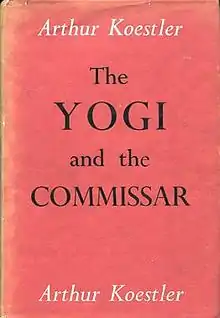The Yogi and the Commissar
The Yogi and the Commissar (1945) is a collection of essays of Arthur Koestler, divided in three parts: Meanderings, Exhortations and Explorations. In the first two parts he has collected essays written from 1942 to 1945 and the third part was written especially for this book.
 First edition cover (Jonathan Cape) | |
| Author | Arthur Koestler |
|---|---|
| Country | United States |
| Language | English |
| Subject | |
| Publisher | Macmillan |
Publication date | 1945 |
| Media type | |
| Pages | 2476 |
| OCLC | 2594319 |
| 940.5 | |
| LC Class | PR6021.O4 |
In the title essay, Koestler proposes a continuum of philosophies for achieving "heaven on earth", from the Commissar at the materialist, scientific end of the spectrum, to the Yogi at the spiritual, metaphysical end. The Commissar wants to change society using any means necessary, while the Yogi wants to change the individual, with an emphasis on ethical purity instead of on results.[1]
"Between these two extremes are spread out in a continuous sequence the spectral lines of the more sedate, human attitudes. The more we approach its centre, the more the spectrum becomes blurred and woolly. On the other hand, this increase of wool on the naked spectral bodies makes them look more decent and intercourse with them more civilized."[2]
One essay, “The Birth of a Myth” published in Horizon, April 1943, appeared as “In Memory of Richard Hillary” in a longer version, pp46–67.
References
- David Robb (Fall 1985). "Brahmins from Abroad". American Studies/University of Kansas. pp. 45–60.
- Arthur Koestler (June 1942). "The Yogi and the Commissar". Horizon.